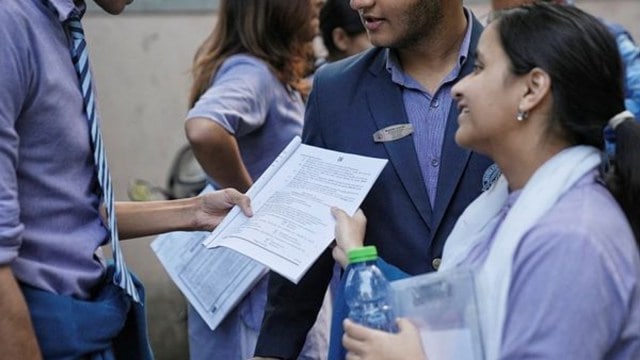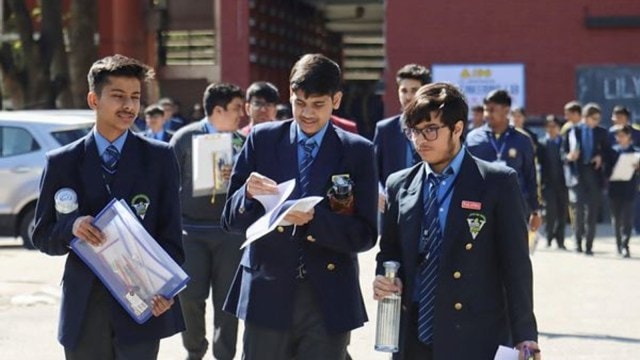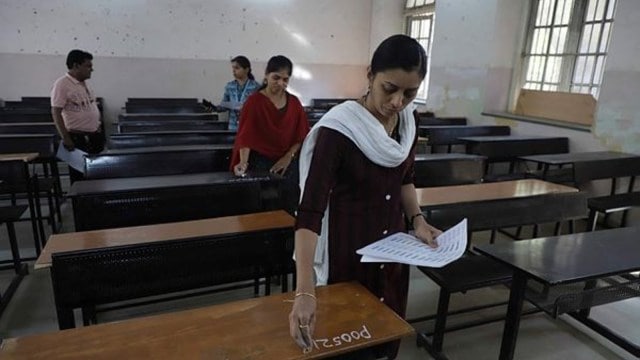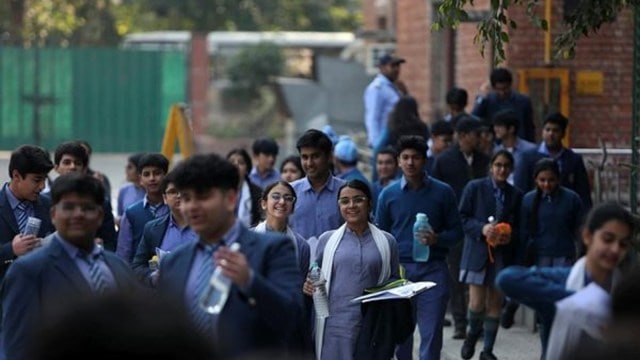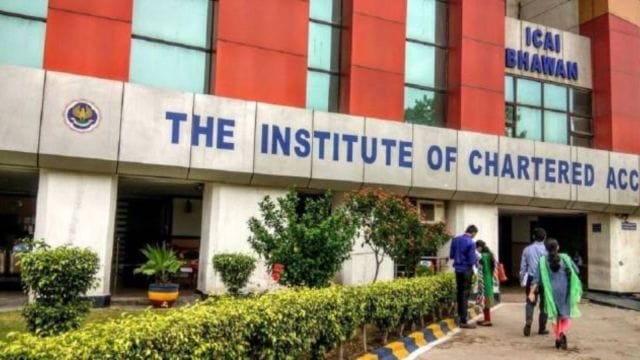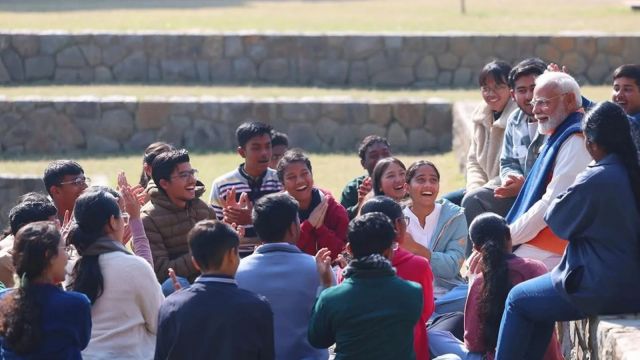
UPSC Key: Undertrial Prisoners in India, Indoor air quality and India-CARICOM SummitSubscriber Only
Important topics and their relevance in UPSC CSE exam for November 21, 2024. If you missed the November 20, 2024 UPSC CSE exam key from the Indian Express, read it here
FRONT PAGE
Delhi moves to 50% work from home, asks pvt. sector to follow
Syllabus:
Preliminary Examination: Current events of national and international importance.
Mains Examination: General Studies III: Conservation, environmental pollution and degradation, environmental impact assessment.
What’s the ongoing story: The Delhi government announced that all its departments and MCD offices will work at 50 per cent capacity while the remaining staff will work from home until curbs under the fourth stage of the Graded Response Action Plan (GRAP) are lifted.
Key Points to Ponder:
• What is the AQI range for the “severe” category?
• What all factors contributes the most to the worsening of air quality in Delhi, as per studies?
• Discuss the significance of the Graded Response Action Plan (GRAP) and its recent amendments in addressing air pollution in Delhi-NCR.
• Analyse the effectiveness of measures like the 50% work-from-home policy and staggered office timings in reducing vehicular emissions.
• What other policy measures can be adopted to address the Air pollution issue in NCR region?
• Evaluate the role of inter-state coordination and technological solutions in mitigating stubble burning.
• Discuss the long-term implications of Delhi’s recurring air pollution crises and suggest a multi-pronged strategy to address this issue.
Key Takeaways:
• Air Quality Crisis in Delhi: The Air Quality Index (AQI) in Delhi has been consistently in the “severe” category, with the 24-hour average AQI reported as 419 on Wednesday. Contributing factors include vehicular emissions and stubble burning, which accounted for 22.1% of pollution on Tuesday.
• Government Actions: The Delhi government has implemented a 50% work-from-home policy for its staff and advised private companies to do the same. Essential services, such as healthcare, sanitation, public transport, law enforcement, and emergency operations, will continue to function at full capacity. Restrictions under the Graded Response Action Plan (GRAP) Stage IV include banning certain vehicles, shutting physical classes in schools, and restricting construction activities.
• Measures for Private Sector: Private offices have been urged to adopt a 50% work-from-home policy and arrange shuttle bus services. Companies are advised to implement staggered office timings to reduce traffic congestion.
• Impact on Schools: Under GRAP-IV, schools have been directed to switch to online classes for both primary and senior classes to reduce exposure to pollution.
• Air Quality and Temperature Correlation: A drop in temperature to 11.2°C, the lowest this season, has contributed to the accumulation of pollutants in the air. Westerly winds and clear skies have facilitated the movement of particulate matter from stubble burning towards Delhi.
• Pollution Data Highlights: Twelve out of 37 monitoring stations in Delhi reported AQI levels above 450. The most polluted areas were Wazirpur (AQI 468) and Ashok Vihar (AQI 467).
• Policy Enforcement: The Commission for Air Quality Management (CAQM) has strengthened GRAP guidelines, making school shutdowns mandatory during severe air quality conditions. The Supreme Court has mandated that these restrictions remain in place until further notice.
• Background Statistics: Delhi houses over 47,000 private enterprises (data from 2018). Nearly 1.4 lakh employees work across 80 government departments and agencies, including the Municipal Corporation of Delhi.
Do You Know:
• The Air Quality Index (AQI) range for the “Severe” category is 401 to 450. Key Characteristics of the “Severe” AQI Category are: —May cause respiratory distress even during light physical activity. —Serious health effects on people with pre-existing conditions, children, and the elderly. —Everyone is likely to be affected; sensitive groups are at a higher risk.
• The “Severe Plus” or “Emergency” category begins when the AQI exceeds 450.
• The fourth stage of the Graded Response Action Plan (GRAP), implemented in Delhi and its surrounding areas to combat air pollution, focuses on emergency measures when air quality reaches the “Severe Plus” or “Emergency” category (AQI level above 450). This stage involves the most stringent measures to address the extreme pollution levels that can pose serious health risks to all residents.
• Key Measures Under Stage IV of GRAP are: —All construction and demolition activities are halted, except for essential projects like railways, metros, and hospitals. —Closure of non-essential industrial units that use unclean fuels. —Only essential industries like those producing life-saving drugs may operate under strict environmental controls. —Entry of all diesel trucks into Delhi, except those carrying essential goods or running on cleaner fuels (CNG, electric). —Schools and educational institutions may be closed, and outdoor activities are prohibited. —Private vehicles may be regulated based on odd-even number plates to reduce vehicular emissions. —Intensive sweeping of roads and sprinkling of water to curb dust. —Strict penalties for garbage burning and improper waste disposal. —Increased deployment of public transport like buses and metro services to discourage private vehicle use. —Government and private organizations may be advised to adopt work-from-home policies to reduce vehicular emissions.
Other Important Articles Covering the same topic:
????Only a third of clean air fund spent in Delhi, pollution body points to absence of key municipal panel
Previous year UPSC Prelims Question Covering similar theme: 1. In the cities of our country, which among the following atmospheric gases are normally considered in calculating the value of Air Quality Index? (UPSC CSE 2016) 1. Carbon dioxide 2. Carbon monoxide 3. Nitrogen dioxide 4. Sulfur dioxide 5. Methane Select the correct answer using the code given below. a) 1, 2 and 3 only b) 2, 3 and 4 only c) 1, 4 and 5 only d) 1, 2, 3, 4 and 5
THE SECOND PAGE
Developing nations say interests of some getting prioritised
Syllabus:
Preliminary Examination: Current events of national and international importance.
Mains Examination: General Studies II: Bilateral, regional and global groupings and agreements involving India and/or affecting India’s interests.
What’s the ongoing story: As the stalemate over climate finance negotiations continues at COP29 in Azerbaijan’s Baku, a group of developing countries Wednesday expressed “concern” and complained that their needs were not being given attention while the interests of the developed countries were being sought to be protected.
Key Points to Ponder:
• The New Collective Quantified Goal (NCQG) aims to establish a new financial target for climate funding to developing nations-True or false?
• What all are the issues causing significant disagreements among countries during COP29?
• Discuss the challenges faced by developing countries in securing adequate climate finance from developed nations.
• Analyse the significance of the New Collective Quantified Goal (NCQG) in the context of international climate negotiations.
• What are the primary points of contention between developed and developing countries regarding the NCQG?
• Evaluate the role of the G20 in addressing global climate change issues.
• How can the G20 facilitate consensus between developed and developing nations on climate finance and emission reduction targets?
• Examine the implications of disagreements over fossil fuel transition and gender language in climate agreements. How do these disagreements affect the overall effectiveness of international climate summits like COP29?
Key Takeaways:
• At the COP29 climate summit in Baku, Azerbaijan, significant tensions have emerged between developed and developing nations over climate finance and emission reduction commitments.
• Financial Demands: Developing countries are advocating for a substantial increase in climate finance, proposing a target of at least $1.3 trillion annually from developed nations to support climate action.
• Equity in Contributions: These nations emphasize the principle of “common but differentiated responsibilities,” asserting that developed countries, having historically contributed more to greenhouse gas emissions, should bear a greater financial burden.
• Developed Nations’ Position: Developed countries suggest that wealthier developing nations also contribute to climate finance, arguing that the current economic landscape has evolved since the original agreements. —Financial Commitments: While acknowledging the need for increased funding, developed nations have not specified exact figures, leading to dissatisfaction among developing countries.
• Key Points of Contention: Disagreements persist over what constitutes climate finance, including the balance between grants and loans, and the sources of these funds. Developing nations express concerns that stringent emission reduction targets could hinder their economic growth, advocating for flexibility in commitments.
• Current Status: Negotiations remain at an impasse, with both blocs holding firm on their positions. The outcome of these discussions is crucial for establishing a new global climate finance goal and determining the future framework for international climate action.
Do You Know:
• COP29, the 29th Conference of the Parties to the United Nations Framework Convention on Climate Change (UNFCCC), is a pivotal international summit addressing global climate change. Held from November 11 to 22, 2024, in Baku, Azerbaijan, this conference brings together representatives from nearly every country to negotiate and implement strategies aimed at mitigating climate change impacts.
• Key Objectives of COP29 are: —A primary focus is setting a new collective quantified goal (NCQG) on climate finance to replace the previous $100 billion annual target. This aims to provide developing nations with the necessary resources to adopt clean energy solutions and build resilience against climate impacts. —Countries are expected to present updated Nationally Determined Contributions (NDCs) that outline their plans to reduce greenhouse gas emissions and adapt to climate change. —Discussions include mechanisms for compensating countries that suffer irreversible losses due to climate change, ensuring that vulnerable nations receive adequate support. —Improving the transparency framework for tracking progress on climate actions and financial flows is essential for building trust among nations and ensuring accountability.
• Controversies and Challenges: —The selection of Azerbaijan, a major oil and gas producer, as the host nation has been controversial. Critics argue that hosting a climate conference in a country heavily reliant on fossil fuels sends mixed signals about global climate commitments. —Additionally, significant divisions have emerged regarding a new global finance deal aimed at supporting poorer countries in combating climate change. The latest proposals offer two extreme options that fail to satisfy any party, leaving key issues unresolved as the deadline approaches.
Other Important Articles Covering the same topic:
????Rio omits fossil fuel phase-out mention, Baku feels the pinch
Previous year UPSC Prelims Question Covering similar theme: 2. With reference to ‘Agenda 21’, sometimes seen in the news, consider the following statements: (UPSC CSE 2016) 1. It is a global action plan for sustainable development. 2. It originated in the World Summit on Sustainable Development held in Johannesburg in 2002. Which of the statements given above is/are correct? a) 1 only b) 2 only c) Both 1 and 2 d) Neither 1 nor 2
GOVT & POLITICS
IN-SPACe looking at private players in ground segments
Syllabus:
Preliminary Examination: Current events of national and international importance.
Mains Examination:
• General Studies II: Government policies and interventions for development in various sectors and issues arising out of their design and implementation.
• General Studies III: Awareness in the fields of IT, Space, Computers, robotics, nano-technology, biotechnology and issues relating to intellectual property rights.
What’s the ongoing story: After satellites and launch vehicles, the Indian National Space Promotion and Authorisation Centre (IN-SPACe) — the central agency for regulating and promoting the private space sector — is looking at ways for entry of private players in ground segments, according to a consultation document prepared by it.
Key Points to Ponder:
• The Indian National Space Promotion and Authorization Centre (IN-SPACe)-Know in brief
• What is Ground station?
• Know the term ground station as a service (GSaaS)
• Discuss the role of IN-SPACe in promoting private sector participation in India’s space sector.
• How IN-SPACe align with the broader objectives of India’s space policy?
• Analyse the potential benefits and challenges of involving private players in the ground segment of space operations in India.
• Evaluate the impact of private sector participation in space activities on India’s technological advancement and economic growth.
• What measures can be taken to ensure a balanced collaboration between public and private entities in India’s Space domain?
• Examine the global trends in privatization of space activities.
Key Takeaways:
• The Indian National Space Promotion and Authorization Center (IN-SPACe) is actively encouraging private sector participation in India’s space industry, particularly in ground segment operations. This initiative aims to enhance the efficiency and reach of satellite services across the nation.
• IN-SPACe is inviting private companies to establish and operate ground stations, which are essential for satellite communication and data reception. This move is expected to foster innovation and improve service delivery in the space sector.
• The organization is implementing policy changes to create a more conducive environment for private enterprises. These reforms include simplifying licensing procedures and providing access to existing government infrastructure, thereby reducing entry barriers for new players.
• IN-SPACe is facilitating partnerships between private firms and government agencies to leverage shared resources and expertise. Such collaborations are anticipated to accelerate the development of ground segment capabilities and expand the range of satellite-based services available to various sectors.
• Ground stations are essentially ground-based antennas that help in communicating with the satellites. Offering ground station as a service (GSaaS) such as satellite control, telemetry and tracking, space data reception, and space situational awareness on pay-per-use basis, the sector has been envisioned to grow 30% by 2033 — from $0.14 billion to $2.5 billion, according to the document. This is in line with the government’s vision to increase India’s share in the global commercial space market from 2% to 8% by 2033.
Do You Know:
• Offering ground stations as a service (GSaaS) has several benefits. Setting up and maintaining ground stations can be exorbitant, and each station provides coverage over a limited area in the low earth orbit.
• A network of ground stations needs to be set up spread across different geographies, building in redundancies or a system that in the event or a problem ensures that operations are uninterrupted, can become expensive. Also, updating technology can also be draining on the finances.
• However, GSaaS is in its nascent stage and there are several challenges that private players face: Unclear regulations for setting it up within the country at the moment, the capital required, getting licence and spectrum, high rates for reception of earth observation data, challenges in on-boarding satellite operators as even that sector is in nascent stages, and high costs of several components needed.
• In July 2024, the Hyderabad-based spacetech startup Dhurva Space became one of the first private players in the country to get approval from IN-SPACe to provide ground station as a service.
Other Important Articles Covering the same topic:
????IN-SPACe explained: what it means to the future of space exploration
Previous year UPSC Mains Question Covering similar theme: ????Discuss India’s achievements in the field of Space Science and Technology. How the application of this technology has helped India in its socio-economic development? (UPSC GS3, 2016)
India, Australia agrees on tie-up in clean energy, push for trade pact
Syllabus:
Preliminary Examination: Current events of national and international importance.
Mains Examination: General Studies II: Bilateral, regional and global groupings and agreements involving India and/or affecting India’s interests.
What’s the ongoing story: India and Australia agreed on an ambitious renewable energy partnership and looked forward to working towards a comprehensive economic cooperation agreement as PM Narendra Modi and his Australian counterpart Anthony Albanese met on the sidelines of the G20 leaders’ Summit in Brazil.
Key Points to Ponder:
• What are the key takeaways from the recent agreements between India and Australia?
• What all areas are India and Australia focusing on for collaboration as per the recent agreements?
• What is the primary objective of the Comprehensive Economic Cooperation Agreement (CECA) between India and Australia?
• Can you name international group in which India and Australia both belong to, aiming to balance China’s influence in the Indo-Pacific region?
• Discuss the significance of the recent agreements between India and Australia in the context of renewable energy collaboration.
• Analyze the potential benefits and challenges of the proposed Comprehensive Economic Cooperation Agreement (CECA) between India and Australia.
• Evaluate the strategic importance of defense and maritime security cooperation between India and Australia.
• The role of international partnerships, such as the Quad, in addressing regional security and economic challenges-brainstorm
Key Takeaways:
• India and Australia have recently agreed to enhance their collaboration in clean energy and expedite the finalization of a comprehensive trade agreement. These initiatives reflect a deepening of the strategic partnership between India and Australia, focusing on sustainable development and mutual economic growth.
• Both nations plan to boost investments in renewable energy sectors, including solar manufacturing, battery production, and mineral processing. This initiative aims to support India’s renewable energy goals and leverage Australia’s expertise in these areas.
• The two countries are committed to concluding negotiations for a Comprehensive Economic Cooperation Agreement (CECA) by the end of this year. This agreement is expected to significantly enhance bilateral trade, with a target of reaching USD 100 billion.
• In addition to economic ties, India and Australia are exploring new avenues for cooperation in defense industries, maritime security, shipbuilding, and space technologies, aiming to strengthen regional security and stability.
Do You Know:
• India and Australia have cultivated a robust bilateral relationship characterized by shared democratic values, economic cooperation, and strategic collaboration. Both nations are members of the Commonwealth and parliamentary democracies with similar legal systems, which has facilitated mutual understanding and cooperation.
• A significant milestone in their economic ties is the India-Australia Economic Cooperation and Trade Agreement (ECTA), which came into effect on December 29, 2022. This agreement aims to enhance bilateral trade by eliminating duties on a vast array of goods and services, thereby fostering economic growth and diversification.
• Strategically, both countries have elevated their partnership to a Comprehensive Strategic Partnership, underscoring their commitment to regional stability and security. This was exemplified during the second 2+2 Ministerial Dialogue held in November 2023, where discussions focused on deepening defense cooperation and addressing shared security challenges.
• In the defense sector, India and Australia have signed agreements to bolster naval ties, reflecting a shared interest in ensuring maritime security in the Indo-Pacific region. These agreements facilitate joint exercises and enhance interoperability between their naval forces.
• While the relationship is strong, both nations acknowledge the presence of differences on certain sensitive matters. Australian officials have expressed confidence in managing these differences through careful and sensitive discussions, emphasizing the maturity and resilience of their bilateral ties.
Other Important Articles Covering the same topic:
????Australia can manage differences with India on sensitive matters: Envoy
Modi first Indian PM to visit Guyana in 56 years, signs 10 pacts to expand ties
Syllabus:
Preliminary Examination: Current events of national and international importance.
Mains Examination: General Studies II: Bilateral, regional and global groupings and agreements involving India and/or affecting India’s interests.
What’s the ongoing story: India and Guyana on Wednesday sealed 10 agreements to strengthen cooperation in hydrocarbons, digital payment systems, pharmaceuticals, and defence after bilateral talks between Prime Minister Narendra Modi and Guyanese President Mohamed Irfaan Ali.
Key Points to Ponder:
• India-CARICOM Summit-Know in details
• What is CARICOM?
• Discuss the significance of Prime Minister Narendra Modi’s visit to Guyana after more than five decades. How does this visit reflect India’s foreign policy priorities in the Caribbean region?
• Analyse the potential areas of cooperation between India and Guyana that were highlighted during PM Modi’s visit. How can these collaborations benefit both nations economically and strategically?
• Evaluate the importance of the India-CARICOM Summit in strengthening India’s relations with Caribbean nations.
• Examine the role of the Indian diaspora in Guyana in fostering bilateral relations between India and Guyana. How does the diaspora contribute to cultural and economic ties between the two countries?
Key Takeaways:
• Prime Minister Narendra Modi’s recent visit to Guyana marked a significant milestone in strengthening India-Guyana relations. This visit was notable as it was the first by an Indian Prime Minister to Guyana in over 50 years. This visit underscores India’s commitment to strengthening its ties with Guyana and the broader Caribbean region, focusing on mutual development and cooperation.
• Upon arrival in Georgetown, PM Modi was honored with the ceremonial ‘Key to the City,’ symbolizing the city’s recognition and respect.
• PM Modi participated in the Second India-CARICOM Summit, engaging with leaders from Caribbean nations to discuss and enhance cooperation in areas such as technology, health, energy, and agriculture.
• In a historic move, PM Modi addressed the Parliament of Guyana, emphasizing the shared heritage and cultural ties between the two nations.
• The Prime Minister interacted with the Indian diaspora in Guyana, acknowledging their contributions to the country’s development and reinforcing the cultural bonds that unite India and Guyana.
• Prime Minister Narendra Modi proposed a framework for strengthening India-CARICOM relations, encapsulated in seven key pillars: —Capacity Building —Agriculture and Food Security —Renewable Energy and Climate Change —Innovation, Technology, and Trade —Cricket and Culture —Ocean Economy —Medicine and Healthcare
Do You Know:
• The Second India-CARICOM Summit was held on November 20, 2024, in Georgetown, Guyana, marking a significant milestone in the relationship between India and the Caribbean Community (CARICOM). This summit was the first of its kind to be hosted in a CARICOM member country, underscoring the deepening ties between the two regions.
• During the summit, India and Guyana signed ten Memorandums of Understanding (MoUs) covering areas such as culture, agriculture, pharmaceuticals, and the deployment of India’s Unified Payments Interface (UPI) in Guyana.
• Prime Minister Modi announced India’s commitment to sharing technology for combating seaweed infestations affecting Caribbean nations. He also pledged over 1,000 scholarships for CARICOM countries, provision of mobile hospitals, drug-testing laboratories, and the introduction of ferries to improve marine transport in the region.
• Acknowledging Guyana’s growing importance as an oil-producing nation, Prime Minister Modi emphasized its role in India’s energy security. He also highlighted the strengthening trade relations between India and Guyana, with India providing lines of credit for various projects, including military passenger planes and river ferries.
• The relationship between India and Guyana is deeply rooted in their shared history as former British colonies and members of the Commonwealth of Nations. A significant portion of Guyana’s population comprises individuals of Indian descent, fostering strong cultural and familial bonds between the two nations.
• In April 2023, External Affairs Minister S. Jaishankar visited Guyana and, alongside President Irfaan Ali, commissioned an India-made ferry, the ‘MA Lisha,’ constructed by Garden Reach Shipbuilders and Engineers in Kolkata. This initiative aims to enhance connectivity and economic opportunities in Guyana’s hinterlands.
• Further strengthening ties, President Mohamed Irfaan Ali of Guyana was the chief guest at the Pravasi Bharatiya Divas convention in Indore in January 2023. During this event, Prime Minister Narendra Modi held bilateral talks with President Ali, focusing on energy cooperation and other areas of mutual interest.
Other Important Articles Covering the same topic:
????EAM Jaishanker joins Guyana’s President Ali at commissioning of India-made ferry
Previous year UPSC Mains Question Covering similar theme: ????Describe, explain and suggest improvement in the state of India’s relationship with Latin America. (UPSC CSE, 2004) ????Why indentured labour was taken by British from India to other colonies? Have they been able to preserve their cultural identity over there? (UPSC CSE, 2018)
THE EDITORIAL PAGE
A new wind in Colombo
Syllabus:
Preliminary Examination: Current events of national and international importance.
Mains Examination: General Studies II: Bilateral, regional and global groupings and agreements involving India and/or affecting India’s interests.
What’s the ongoing story: Andrew Fidel Fernando Writes: It has long been argued that equality of economic opportunity is key to producing social change in Sri Lanka. But previous liberal projects have largely refused to make economic rights a component of their calls for justice – will NPP break the curse?
Key Points to Ponder:
• India and Sri Lanka and National People’s Power (NPP) coalition-Connect the dots
• What is the significance of the NPP’s recent electoral performance in Jaffna?
• Discuss the implications of the National People’s Power (NPP) coalition’s recent electoral success in Sri Lanka.
• Analyze the factors that contributed to the NPP’s ability to gain traction among Tamil and Muslim minorities in Sri Lanka.
• Evaluate the potential challenges and opportunities that the NPP may face in implementing its agenda focused on economic justice over ethnic nationalism.
• Examine the role of voter sentiment in the recent parliamentary elections in Sri Lanka.
Key Takeaways:
• The author Andrew Fidel Fernando in his article “A New Wind in Colombo” discusses the recent political developments in Sri Lanka, focusing on the rise of the National People’s Power (NPP) coalition and its implications for the nation’s future. In summary, the article highlights a transformative moment in Sri Lankan politics, with the NPP’s rise signalling a possible departure from traditional ethnic-based politics towards a focus on economic reform and inclusivity.
• The NPP, led by Anura Kumara Dissanayake, has transitioned from a fringe political entity to a dominant force, securing a significant majority in the recent parliamentary elections. This shift reflects a growing public desire for change amid economic challenges and dissatisfaction with traditional parties.
• The coalition’s platform prioritizes economic justice over ethnic nationalism, appealing to a broad spectrum of voters across different communities. This approach has resonated with citizens seeking solutions to economic instability and corruption.
• Notably, the NPP made inroads into Tamil-majority regions, traditionally dominated by ethnic parties. This development suggests a potential shift towards more inclusive politics, moving beyond ethnic divisions.
• Despite its electoral victory, the NPP faces the task of delivering on its promises, particularly in addressing economic issues and maintaining unity among diverse communities. The coalition’s success will depend on its ability to implement effective policies and uphold its commitment to economic justice.
Do You Know:
• India and Sri Lanka share a multifaceted relationship characterized by deep historical ties, economic cooperation, and strategic collaboration. The both nation continues to build upon their historical connections, focusing on economic development, defense cooperation, and cultural exchanges to foster a robust and mutually beneficial partnership.
• In September 2024, Anura Kumara Dissanayake was elected as Sri Lanka’s President. Despite his party’s historical scepticism towards India, Dissanayake has acknowledged India’s crucial role in Sri Lanka’s security and economic development. He has not indicated a preference for prioritizing relations with China over India, suggesting a balanced foreign policy approach.
• In July 2024, India and Sri Lanka unveiled a vision for deeper economic ties. Prime Minister Narendra Modi emphasized the importance of fulfilling the aspirations of the Tamil community in Sri Lanka. The two countries agreed to conduct feasibility studies on a petroleum pipeline and land bridge connectivity, aiming to enhance trade and energy cooperation.
• The 10th edition of the joint military exercise ‘Mitra Shakti’ commenced in August 2024 at the Army Training School in Maduru Oya, Sri Lanka. This annual exercise, conducted alternately in India and Sri Lanka, aims to enhance interoperability and share best practices between the two armies.
• During Sri Lanka’s economic crisis, India extended significant support. In May 2024, Sri Lanka’s Prime Minister acknowledged India’s assistance during the COVID-19 pandemic and the economic downturn, highlighting the importance of strengthening ties based on good neighbourly relations.
• In October 2024, a ferry service between Nagapattinam in India and Kankesanthurai in Sri Lanka was launched, marking a significant milestone in strengthening bilateral relations. This service is expected to enhance connectivity, promote trade, and reinforce longstanding cultural bonds between the two nations.
Other Important Articles Covering the same topic:
????Shyam Saran writes: Why political uncertainty in Sri Lanka may not mean it draws away from India
Previous year UPSC Prelims Question Covering similar theme: 3. Consider the following statements: (UPSC CSE, 2020) 1. The value of Indo-Sri Lanka trade has consistently increased in the last decade. 2. “Textile and textile articles” constitute an important item of trade between India and Bangladesh. 3. In the last five years, Nepal has been the largest trading partner of India in South Asia. Which of the statements given above is/are correct? (a) 1 and 2 only (b) 2 only (c) 1 and 3 only (d) 1, 2 and 3 Previous year UPSC Mains Question Covering similar theme: ????India is an age-old friend of Sri Lanka.’ Discuss India’s role in the recent crisis in Sri Lanka in the light of the preceding statement. (UPSC CSE, GS2, 2022) ????In respect of India — Sri Lanka relations, discuss how domestic factors influence foreign policy. (UPSC CSE, GS2, 2013)
ECONOMY
Trump-Musk bromance could shape the future of digital data flows, including for India
Syllabus:
Preliminary Examination: Current events of national and international importance.
Mains Examination: General Studies II: Effect of policies and politics of developed and developing countries on India’s interests, Indian diaspora.
What’s the ongoing story: Tesla CEO Elon Musk’s growing influence over the White House, following his backing of Donald Trump’s re-election bid, is expected to usher in a new era of deregulation for Big Tech companies in the United States.
Key Points to Ponder:
• Discuss the potential implications of Elon Musk’s support for Donald Trump on global digital data flows. How could this relationship influence data policies in countries like India?
• Analyze the role of tech industry leaders in shaping political outcomes, with reference to the 2024 U.S. Presidential elections. What are the ethical considerations of such involvement?
• Evaluate the potential challenges and opportunities for India in navigating its digital data policies amidst changing global political dynamics, particularly the Musk-Trump alliance.
• Examine the influence of social media platforms, like X, in political campaigns. How does ownership and control of such platforms by individuals like Elon Musk affect democratic processes?
Key Takeaways:
• Elon Musk, owner of X (formerly Twitter), has been a prominent supporter of Donald Trump’s presidential campaign. This alliance has raised concerns about the influence of their partnership on digital platforms and data governance.
• The collaboration between Musk and Trump could lead to policy shifts affecting digital data flows. There are apprehensions that this partnership might influence regulations related to data privacy, content moderation, and the operation of digital platforms.
• India, with its vast digital user base, could be significantly affected by any changes in data policies resulting from the Musk-Trump partnership. Potential areas of impact include data localization requirements, cross-border data transfer regulations, and the operations of social media platforms within the country.
Do You Know:
• Data localisation mandates that data generated within a country’s borders be stored and processed domestically. In India, this concept has gained prominence with the Reserve Bank of India’s (RBI) directive requiring payment system operators to store all payment data exclusively in India. This move aims to enhance data security and ensure regulatory oversight.
• The implementation of stringent data localisation norms has sparked debates. Critics argue that such measures could lead to the “Balkanisation of the internet,” potentially increasing operational costs for global companies and hindering the free flow of information. S. Chandrasekhar, Director of Government Affairs at Microsoft, highlighted that while strategic control might necessitate some localisation, a “one-size-fits-all” approach could be detrimental.
• While data localisation aims to bolster national security and economic interests, it must be balanced with data privacy considerations. Overly restrictive localisation policies could impede innovation and international trade. Therefore, a nuanced approach is essential to protect individual privacy rights while fostering a conducive environment for technological advancement and economic growth.
Other Important Articles Covering the same topic:
????Government’s Data Protection Bill is worried about privacy too
Previous year UPSC Mains Question Covering similar theme: ????Data security has assumed significant importance in the digitized world due to rising cybercrimes. The Justice B.N. Srikrishna Committee Report addresses issues related to data security. What, in essence, are its recommendations? (UPSC CSE, Mains, 2018)
EXPLAINED
What to know about indoor air quality and purification
Syllabus:
Preliminary Examination: Current events of national and international importance.
Mains Examination: General Studies III: Conservation, environmental pollution and degradation, environmental impact assessment.
What’s the ongoing story: The more privileged among us spend most of the day indoors — in homes, offices, gyms, and air-conditioned vehicles — where air quality can be controlled. Outdoor exposure is typically limited to commutes or errands, during which a properly fitted N95 mask is the only reliable way to reduce exposure to harmful pollutants.
Key Points to Ponder:
• Indoor air pollution can be more harmful than outdoor air pollution-True or false?
• Common indoor pollutants include volatile organic compounds (VOCs) and particulate matter-True or false?
• What are the common sources of indoor air pollution?
• What is the primary function of High-Efficiency Particulate Air (HEPA) filters in air purifiers?
• Discuss the health implications of poor indoor air quality.
• What strategies can be implemented to mitigate indoor air pollution in urban households?
• Analyse the effectiveness of various air purification technologies, such as HEPA filters and activated carbon filters, in improving indoor air quality.
• Examine the challenges in regulating indoor air quality standards in India.
Key Takeaways:
• Indoor air quality (IAQ) significantly impacts health and well-being, especially in urban areas with high pollution levels. Understanding IAQ and effective purification methods is essential for maintaining a healthy indoor environment.
• External pollutants like vehicle emissions and industrial discharges can infiltrate indoor spaces, contributing to poor IAQ. Common household activities such as cooking, smoking, and using certain cleaning agents release pollutants like particulate matter and volatile organic compounds (VOCs). Materials used in construction and furnishings can emit VOCs and other harmful substances over time.
• Exposure to indoor pollutants can lead to respiratory issues, allergies, and other health problems. Vulnerable groups, including children, the elderly, and individuals with pre-existing health conditions, are particularly at risk.
• Ensuring adequate ventilation helps dilute indoor pollutants. However, in areas with high outdoor pollution, it’s crucial to balance ventilation with filtration to prevent introducing more contaminants indoors.
• Devices equipped with High-Efficiency Particulate Air (HEPA) filters can effectively remove particulate matter from indoor air. It’s important to choose purifiers appropriate for the room size and to maintain them regularly.
• Certain plants can absorb pollutants and improve IAQ. However, their effectiveness is limited, and they should complement other purification methods rather than replace them.
• Minimizing the use of products that emit VOCs, such as specific paints and cleaning agents, can reduce indoor pollution. Keeping HVAC systems and air purifiers in good condition ensures their optimal performance in maintaining IAQ. Maintaining indoor humidity levels between 30-50% can prevent mold growth and reduce dust mites, both of which can affect IAQ.
Do You Know:
• An air purifier is essentially a fan paired with a HEPA (High Efficiency Particulate Air) filter, designed to trap fine particulate matter like PM2.5. Many modern purifiers come with sensors that automatically adjust fan speed based on air quality, improving efficiency. For those on a budget, a DIY purifier can be made using a HEPA filter and a fan. HEPA filters are critical for trapping PM2.5, while activated carbon filters, though not essential for particulate matter alone, are useful for capturing gaseous pollutants.
• A key metric is the Clean Air Delivery Rate (CADR), which indicates how quickly a purifier can filter air in a given space. Higher CADR ratings are particularly important for larger rooms. It is essential to avoid purifiers that generate ozone, as they can do more harm than good. While stratospheric ozone protects us from UV radiation, ground-level “bad ozone” can worsen indoor air quality by producing additional pollutants through chemical reactions.
• While air purifiers and similar measures can reduce health risks for those who can afford them, these solutions are inherently inequitable. This selective insulation can also diminish the urgency to push for systemic changes, which ultimately perpetuates the problem.
Other Important Articles Covering the same topic:
????How air pollution can sap your productivity and focus
India’s undertrial prisoners
Syllabus:
Preliminary Examination: Sustainable Development, Poverty, Inclusion, Demographics, Social Sector Initiatives, etc.
Mains Examination: General Studies II: Government policies and interventions for development in various sectors and issues arising out of their design and implementation.
What’s the ongoing story: Union Home Minister Amit Shah on Tuesday said that undertrials who have spent more than a third of the maximum prescribed sentence for the crime they are accused of committing should be released before Constitution Day (November 26).
Key Points to Ponder:
• What does Section 479 of the BNSS, which provides relaxed bail standards for first-time offenders, state?
• What is the state of undertrials in India?
• Discuss the implications of a high percentage of undertrial prisoners on the Indian criminal justice system.
• Analyse the recent Supreme Court ruling on relaxing bail provisions for first-time offenders.
• Evaluate the role of legal aid and representation in reducing the number of undertrial prisoners.
• What steps can be taken to ensure timely and effective legal assistance for undertrials?
• Examine the challenges faced by the Indian judiciary in expediting trials for undertrial prisoners.
• How can systemic reforms contribute to alleviating the problem of prolonged detention without conviction?
Key Takeaways:
• India’s prison system faces significant challenges, particularly concerning the high proportion of undertrial prisoners and issues of overcrowding.
• As per the National Crime Records Bureau’s (NCRB) 2022 report, undertrial prisoners constitute approximately 75% of the total prison population in India. The same report indicates that India’s 1,330 prisons have an occupancy rate of 131.4%, highlighting severe overcrowding issues.
• Prolonged court proceedings result in extended pre-trial detentions, contributing to the high number of undertrial prisoners. Many undertrial prisoners come from marginalized communities and lack the financial resources to secure bail or legal representation.
• In August 2024, the Supreme Court ruled that the relaxation of bail provisions for first-time offenders should apply retrospectively. This decision is expected to impact a significant number of undertrial prisoners, potentially reducing their numbers.
• The Union Law and Justice Minister has urged state legal services authorities to intensify efforts to provide legal aid to undertrial prisoners, aiming for their release by significant national milestones.
• The prolonged detention of undertrial prisoners raises serious human rights issues, including the right to a fair and speedy trial. Addressing these challenges requires comprehensive reforms in the judicial process, including expediting trials, improving legal aid services, and implementing alternative dispute resolution mechanisms.
Do You Know:
• Section 479 of the BNSS lays down the “Maximum period for which [an] undertrial prisoner can be detained”. It states that a prisoner who is not accused of offences punishable with death or life imprisonment shall be released on bail if she has “undergone detention for a period extending up to one-half of the maximum period of imprisonment specified for that offence under that law”.
• In August, a Bench of Justices Hima Kohli and Sandeep Mehta held hearings on the issues faced by undertrial prisoners in the case In re: Inhuman conditions in 1382 prisons. The case began as a PIL after former Chief Justice of India R C Lahoti sent a letter to the court, highlighting issues such as overcrowding in prisons, unnatural deaths of prisoners, and the inadequacy of trained prison staff. Since 2013, the court has been hearing issues relating to prisons in this case.
• According to the National Crime Records Bureau’s report Prison Statistics India 2022 (published in December 2023), of the 5,73,220 people incarcerated in Indian prisons, 4,34,302 are undertrials against whom cases are still pending. That amounts to nearly 75.8% of all prisoners in India. —Of the 23,772 women in prisons, 18,146 (76.33%) are undertrials, the report notes. —The report does not record how many undertrial prisoners were first-time offenders. —As of December 31, 2022, around 8.6% of all undertrial prisoners had been in prison for more than three years.
• Constitution Day, also known as Samvidhan Divas, is observed annually in India on November 26 to commemorate the adoption of the Indian Constitution by the Constituent Assembly on this day in 1949. The Constitution came into effect on January 26, 1950, marking the country’s transition to a republic.
• The observance of Constitution Day was initiated in 2015 to honor Dr. B.R. Ambedkar, the principal architect of the Indian Constitution, on his 125th birth anniversary. The day serves to highlight the significance of the Constitution in guiding India’s democratic framework and to promote awareness of citizens’ rights and duties.
Other Important Articles Covering the same topic:
????Explained: Supreme Court ruling on relaxing bail provision for first-time offenders to apply retrospectively
For any queries and feedback, contact priya.shukla@indianexpress.com
Subscribe to our UPSC newsletter. Stay updated with the latest UPSC articles by joining our Telegram channel – IndianExpress UPSC Hub, and follow us on Instagram and X.

 Posts
Posts Sign up as a Teacher
Sign up as a Teacher